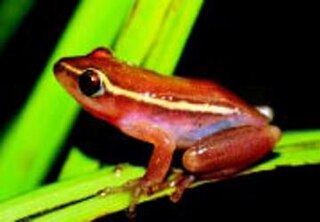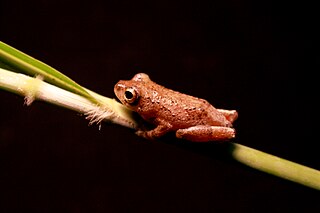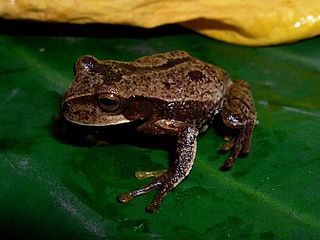
Boettger's horned toad, also known as Boettger's spadefoot toad or the pale-shouldered horned toad, is a species of toad found in southern and southeastern China and north-eastern India. A closely related but probably as yet undescribed species in found in Tibet. It is not certain that the Indian specimens belong to Megophrys boettgeri either.
Afrixalus lacteus is a species of frog in the family Hyperoliidae. It is endemic to Cameroon and known from a few mountains in the western part of the country; specifically, it has been recorded from Mount Manengouba, Mount Nlonaka, and the southern Bamileke Highlands. Common name Cameroon banana frog has been coined for it. Prior to its description, it was confused with Afrixalus lindholmi.
Afrixalus laevis is a species of frog in the family Hyperoliidae. It is found in southern Cameroon, northern Gabon, Bioko, the Democratic Republic of the Congo, and southwestern Uganda. Its range may extend to the neighboring countries. Common names smooth spiny reed frog and Liberia banana frog have been coined for it.

Afrixalus morerei is a species of frog in the family Hyperoliidae. It is endemic to the Udzungwa Mountains in Tanzania. It was originally described as a subspecies of Afrixalus septentrionalis, but is currently recognized as a full species. The specific name morerei honours Jean-Jacques Morère, a French herpetologist from the National Museum of Natural History, Paris. Its common names are Morère's spiny reed frog, Dabaga's leaf-folding frog, and Morere's banana frog.
Afrixalus orophilus is a species of frog in the family Hyperoliidae. It is found in Kivu in the eastern Democratic Republic of the Congo, Burundi, Rwanda, and southwestern Uganda. Common names Kivu banana frog, montane spiny reed frog, and two-lined leaf-gluing frog has been coined for it.
Afrixalus osorioi is a species of frog in the family Hyperoliidae. It is found in Angola, Democratic Republic of the Congo, Gabon, western Kenya, and Uganda. The specific name osorioi honours Balthazar Osório, a Portuguese ichthyologist. Its common names include Angola banana frog, Osorio's spiny reed frog, Congro spiny reed frog, and forest tree frog.
Hyperolius balfouri is a species of frog in the family Hyperoliidae. It is found in Cameroon, Central African Republic, northeastern Democratic Republic of the Congo, South Sudan, southwestern Ethiopia, Uganda, and western Kenya. The specific name balfouri honours J.W. Balfour, a missionary in Uganda. Common names Balfour's reed frog and Ethiopia reed frog have been coined for this species, with the latter name referring to the now-synonymized Hyperolius zavattarii. Populations from the western part of the range may be referred to the subspecies Hyperolius balfouri viridistriatus.
Hyperolius bolifambae is a species of frog in the family Hyperoliidae. It is known from southeastern Nigeria, southern Cameroon, and southwestern Central African Republic, with an isolated record in northeastern Democratic Republic of the Congo ; the latter record may be considered doubtful. It likely has a broader range towards south and east than currently documented, and the AmphibiaWeb includes Gabon and the Republic of the Congo in the distribution.
Hyperolius camerunensis is a species of reed frog in the family Hyperoliidae. It is endemic to western and southwestern Cameroon.
Hyperolius diaphanus is a species of frog in the family Hyperoliidae. It is endemic to the eastern Democratic Republic of the Congo and is known from near the Itombwe Mountains and the mountains to the west of Lake Kivu. Limits of its range are not clear and might extend into the adjacent Burundi and Rwanda. Common names Kigulube reed frog and translucent reed frog have been proposed for this species.

Hyperolius kihangensis, also known as the Kihanga reed frog or volcano reed frog, is a species of frogs in the family Hyperoliidae. It is endemic to the Udzungwa Mountains in south-central Tanzania.

Hyperolius mitchelli is a species of frogs in the family Hyperoliidae. It is found in the area between northeastern Tanzania, Malawi, and central Mozambique.
Hyperolius molleri is a species of frog in the family Hyperoliidae. It is endemic to São Tomé Island. Records from Príncipe now refer to Hyperolius drewesi, described as a distinct species in 2016.

Pickersgill's reed frog is a species of frog in the family Hyperoliidae. It is endemic to South Africa. It occurs in the coastal lowlands of KwaZulu-Natal between Sezela and St Lucia.

Hyperolius tuberculatus is a species of frog in the family Hyperoliidae. Its common name is rainforest reed frog. It ranges from the southeastern Nigeria to the Central Africa in Cameroon, western Central African Republic, Equatorial Guinea, Gabon, Republic of the Congo, and Democratic Republic of the Congo. It is also likely to occur in the Cabinda enclave of Angola.
Leptopelis susanae is a species of frog in the family Arthroleptidae. It is endemic to southwest Ethiopia and known from the Gughe Mountains and Saja Forest. The specific name susanae honours Susan, the wife of the describer, Malcolm Largen. Common names Susan's tree frog and Susana's [sic] forest treefrog have been coined for this species.
Leptopelis yaldeni is a species of frog in the family Arthroleptidae. It is endemic to Ethiopia and occurs in the montane highlands in Gojjam. Its range might be limited by the deep gorges of the Blue Nile. It is named in honour of Derek Yalden, a British zoologist who collected some of the types. Common names Yalden's tree frog and grassland forest treefrog have been coined for this species.
Phlyctimantis keithae is a species of frog in the family Hyperoliidae. It is endemic to the Udzungwa Mountains, Tanzania. The specific name keithae honors Rolanda Keith, an American herpetologist.
Craugastor fleischmanni is a species of frog in the family Craugastoridae. It is endemic to Costa Rica where it has been found on the Meseta Central Oriental and Occidental, the Pacific slopes of the Barva and Poás Volcanos, the Atlantic slopes of the Irazú and Turrialba Volcanos, and on the Cordillera de Talamanca. Common name Fleischmann's robber frog has been suggested for this species.

Gastrotheca argenteovirens is a species of frog in the family Hemiphractidae. It is endemic to Colombia and occurs in the Colombian Massif, Cordillera Central, and Cordillera Occidental in the Quindío, Tolima, Valle del Cauca, Cauca, and Nariño Departments. Common name Popayan marsupial frog has been coined for it.








